Detailed Analysis: Methodological Approaches in Research Report
VerifiedAdded on 2022/09/14
|10
|1950
|18
Report
AI Summary
This report delves into the intricacies of methodological approaches in research, providing a comprehensive overview of qualitative, quantitative, and mixed methods. It begins by establishing the foundational concepts of epistemology and ontology, crucial for understanding research design. The report then examines the strengths, limitations, and applications of each methodological approach, offering examples and case studies to illustrate their practical use. It highlights the importance of ethical considerations and the factors influencing the selection of an appropriate methodology, such as research aims and data requirements. The report also addresses how to combine qualitative and quantitative methods to quantify the level of quality. Finally, it concludes with a discussion of the researcher's chosen field of cartography, justifying the selection of a mixed-method approach for its ability to integrate both numerical and descriptive data analysis, providing a holistic perspective on the research topic.
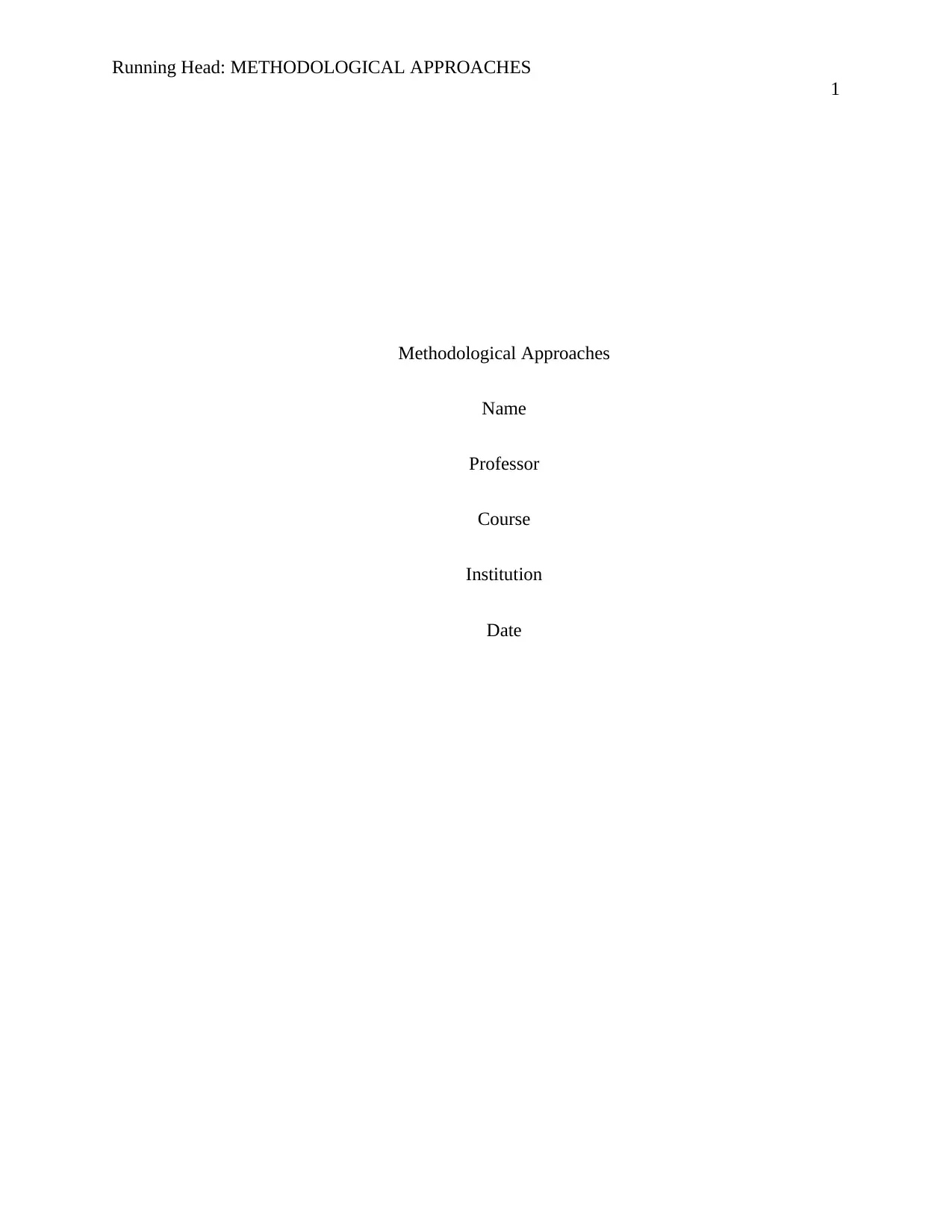
Running Head: METHODOLOGICAL APPROACHES
1
Methodological Approaches
Name
Professor
Course
Institution
Date
1
Methodological Approaches
Name
Professor
Course
Institution
Date
Paraphrase This Document
Need a fresh take? Get an instant paraphrase of this document with our AI Paraphraser
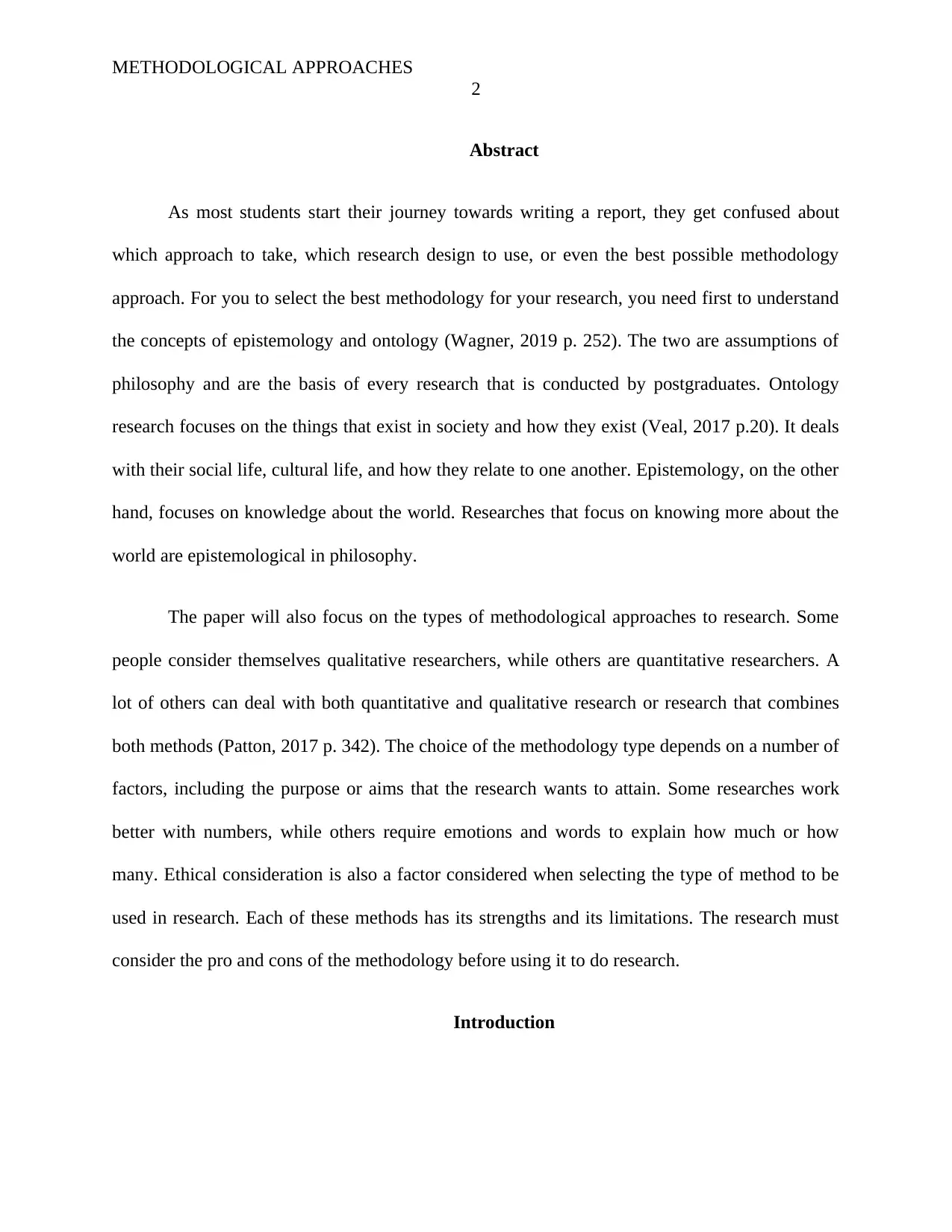
METHODOLOGICAL APPROACHES
2
Abstract
As most students start their journey towards writing a report, they get confused about
which approach to take, which research design to use, or even the best possible methodology
approach. For you to select the best methodology for your research, you need first to understand
the concepts of epistemology and ontology (Wagner, 2019 p. 252). The two are assumptions of
philosophy and are the basis of every research that is conducted by postgraduates. Ontology
research focuses on the things that exist in society and how they exist (Veal, 2017 p.20). It deals
with their social life, cultural life, and how they relate to one another. Epistemology, on the other
hand, focuses on knowledge about the world. Researches that focus on knowing more about the
world are epistemological in philosophy.
The paper will also focus on the types of methodological approaches to research. Some
people consider themselves qualitative researchers, while others are quantitative researchers. A
lot of others can deal with both quantitative and qualitative research or research that combines
both methods (Patton, 2017 p. 342). The choice of the methodology type depends on a number of
factors, including the purpose or aims that the research wants to attain. Some researches work
better with numbers, while others require emotions and words to explain how much or how
many. Ethical consideration is also a factor considered when selecting the type of method to be
used in research. Each of these methods has its strengths and its limitations. The research must
consider the pro and cons of the methodology before using it to do research.
Introduction
2
Abstract
As most students start their journey towards writing a report, they get confused about
which approach to take, which research design to use, or even the best possible methodology
approach. For you to select the best methodology for your research, you need first to understand
the concepts of epistemology and ontology (Wagner, 2019 p. 252). The two are assumptions of
philosophy and are the basis of every research that is conducted by postgraduates. Ontology
research focuses on the things that exist in society and how they exist (Veal, 2017 p.20). It deals
with their social life, cultural life, and how they relate to one another. Epistemology, on the other
hand, focuses on knowledge about the world. Researches that focus on knowing more about the
world are epistemological in philosophy.
The paper will also focus on the types of methodological approaches to research. Some
people consider themselves qualitative researchers, while others are quantitative researchers. A
lot of others can deal with both quantitative and qualitative research or research that combines
both methods (Patton, 2017 p. 342). The choice of the methodology type depends on a number of
factors, including the purpose or aims that the research wants to attain. Some researches work
better with numbers, while others require emotions and words to explain how much or how
many. Ethical consideration is also a factor considered when selecting the type of method to be
used in research. Each of these methods has its strengths and its limitations. The research must
consider the pro and cons of the methodology before using it to do research.
Introduction
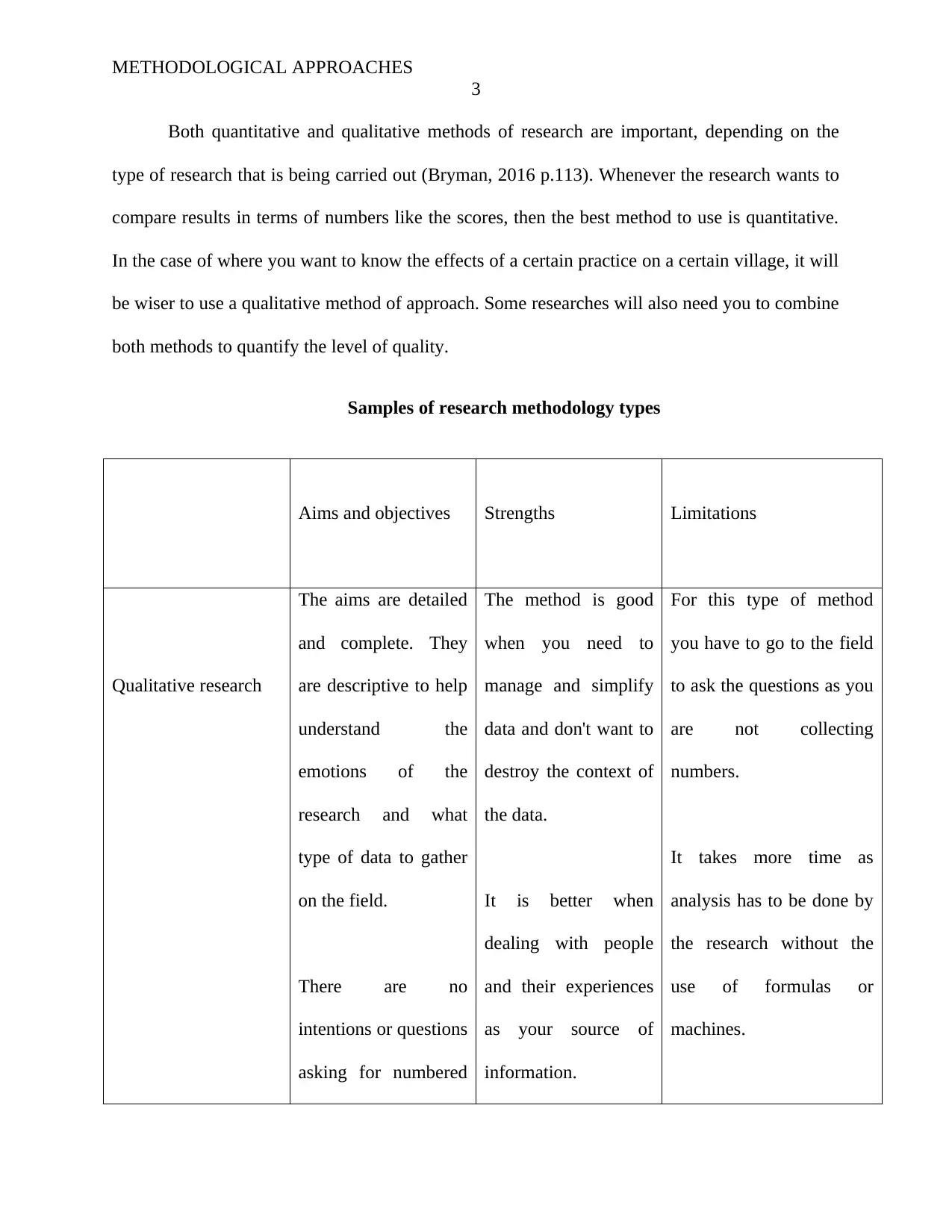
METHODOLOGICAL APPROACHES
3
Both quantitative and qualitative methods of research are important, depending on the
type of research that is being carried out (Bryman, 2016 p.113). Whenever the research wants to
compare results in terms of numbers like the scores, then the best method to use is quantitative.
In the case of where you want to know the effects of a certain practice on a certain village, it will
be wiser to use a qualitative method of approach. Some researches will also need you to combine
both methods to quantify the level of quality.
Samples of research methodology types
Aims and objectives Strengths Limitations
Qualitative research
The aims are detailed
and complete. They
are descriptive to help
understand the
emotions of the
research and what
type of data to gather
on the field.
There are no
intentions or questions
asking for numbered
The method is good
when you need to
manage and simplify
data and don't want to
destroy the context of
the data.
It is better when
dealing with people
and their experiences
as your source of
information.
For this type of method
you have to go to the field
to ask the questions as you
are not collecting
numbers.
It takes more time as
analysis has to be done by
the research without the
use of formulas or
machines.
3
Both quantitative and qualitative methods of research are important, depending on the
type of research that is being carried out (Bryman, 2016 p.113). Whenever the research wants to
compare results in terms of numbers like the scores, then the best method to use is quantitative.
In the case of where you want to know the effects of a certain practice on a certain village, it will
be wiser to use a qualitative method of approach. Some researches will also need you to combine
both methods to quantify the level of quality.
Samples of research methodology types
Aims and objectives Strengths Limitations
Qualitative research
The aims are detailed
and complete. They
are descriptive to help
understand the
emotions of the
research and what
type of data to gather
on the field.
There are no
intentions or questions
asking for numbered
The method is good
when you need to
manage and simplify
data and don't want to
destroy the context of
the data.
It is better when
dealing with people
and their experiences
as your source of
information.
For this type of method
you have to go to the field
to ask the questions as you
are not collecting
numbers.
It takes more time as
analysis has to be done by
the research without the
use of formulas or
machines.
⊘ This is a preview!⊘
Do you want full access?
Subscribe today to unlock all pages.

Trusted by 1+ million students worldwide
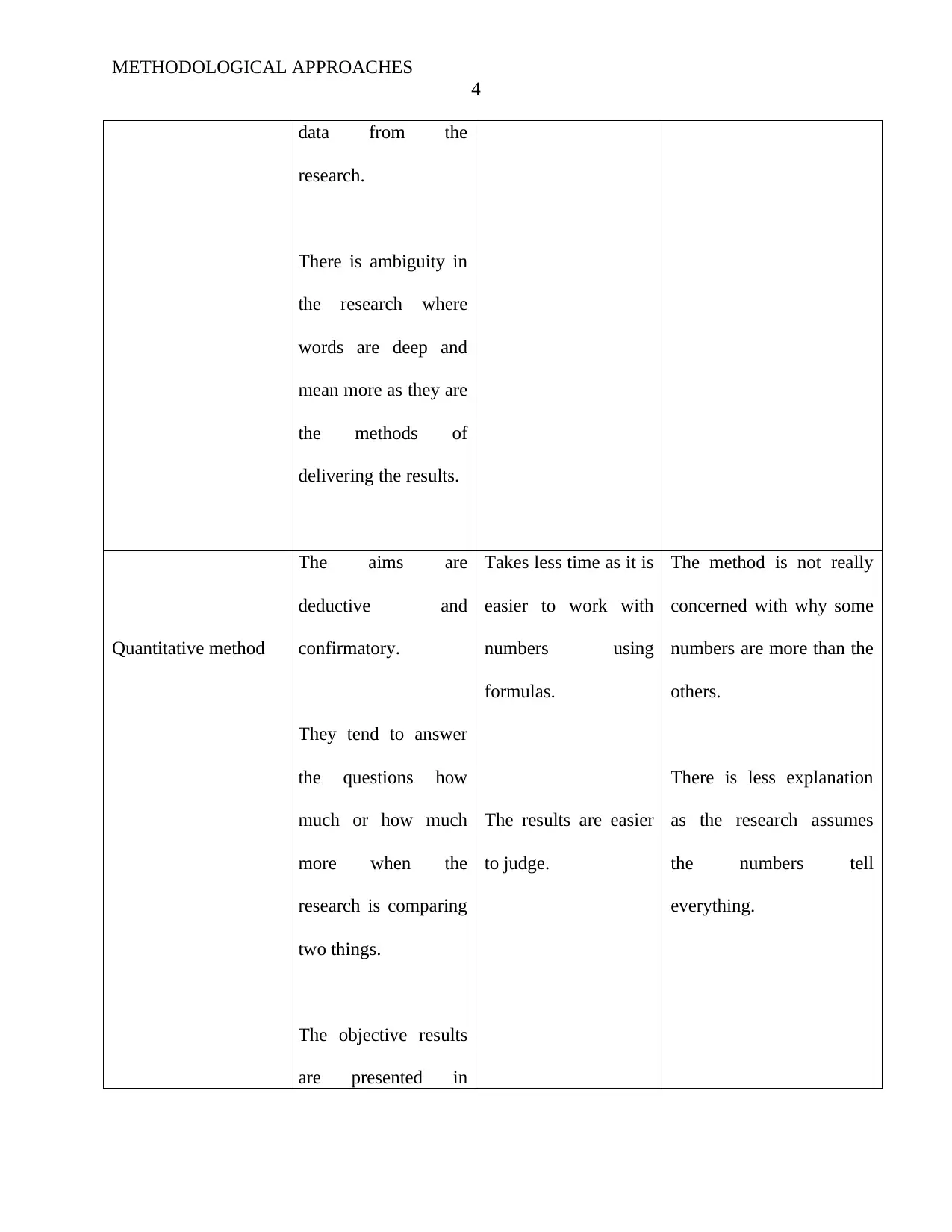
METHODOLOGICAL APPROACHES
4
data from the
research.
There is ambiguity in
the research where
words are deep and
mean more as they are
the methods of
delivering the results.
Quantitative method
The aims are
deductive and
confirmatory.
They tend to answer
the questions how
much or how much
more when the
research is comparing
two things.
The objective results
are presented in
Takes less time as it is
easier to work with
numbers using
formulas.
The results are easier
to judge.
The method is not really
concerned with why some
numbers are more than the
others.
There is less explanation
as the research assumes
the numbers tell
everything.
4
data from the
research.
There is ambiguity in
the research where
words are deep and
mean more as they are
the methods of
delivering the results.
Quantitative method
The aims are
deductive and
confirmatory.
They tend to answer
the questions how
much or how much
more when the
research is comparing
two things.
The objective results
are presented in
Takes less time as it is
easier to work with
numbers using
formulas.
The results are easier
to judge.
The method is not really
concerned with why some
numbers are more than the
others.
There is less explanation
as the research assumes
the numbers tell
everything.
Paraphrase This Document
Need a fresh take? Get an instant paraphrase of this document with our AI Paraphraser
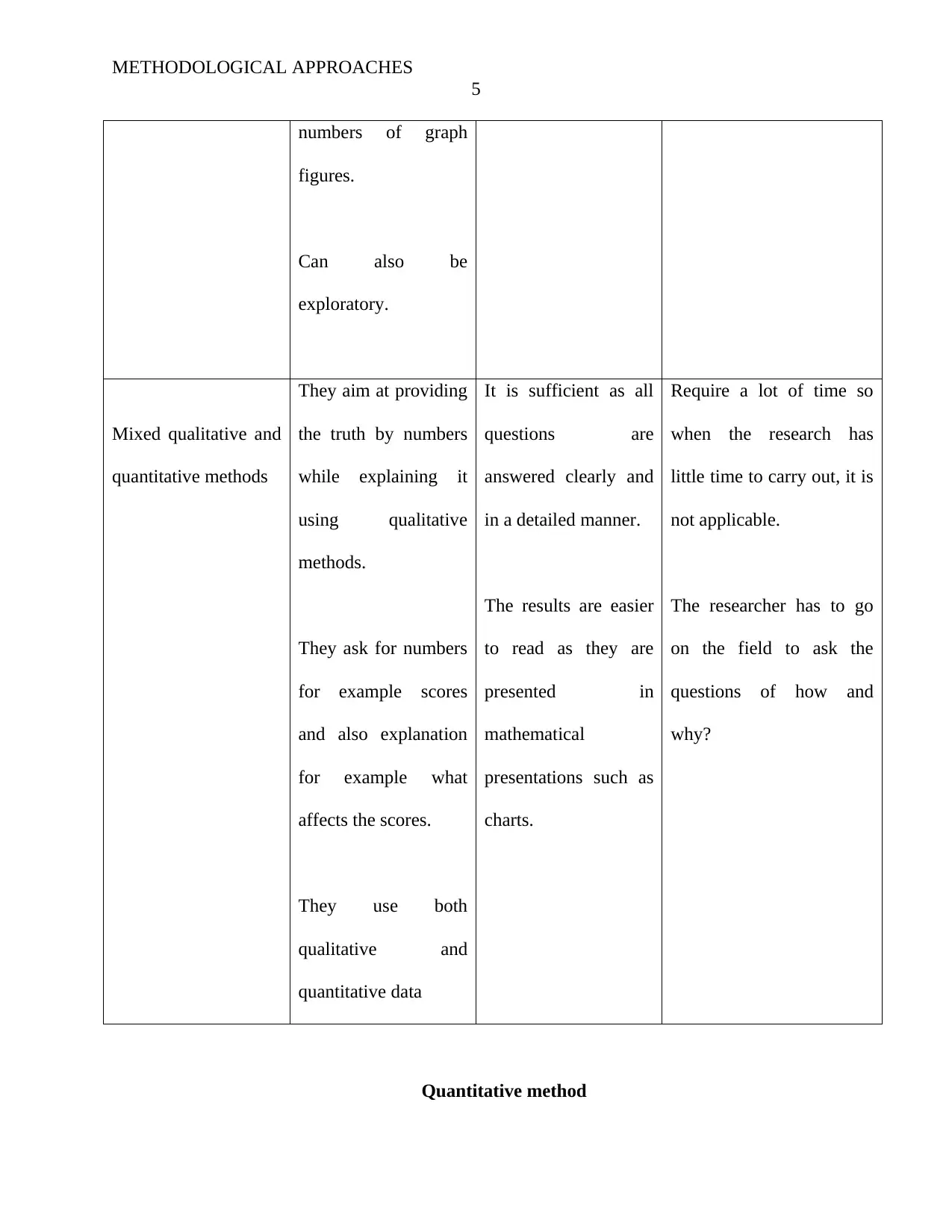
METHODOLOGICAL APPROACHES
5
numbers of graph
figures.
Can also be
exploratory.
Mixed qualitative and
quantitative methods
They aim at providing
the truth by numbers
while explaining it
using qualitative
methods.
They ask for numbers
for example scores
and also explanation
for example what
affects the scores.
They use both
qualitative and
quantitative data
It is sufficient as all
questions are
answered clearly and
in a detailed manner.
The results are easier
to read as they are
presented in
mathematical
presentations such as
charts.
Require a lot of time so
when the research has
little time to carry out, it is
not applicable.
The researcher has to go
on the field to ask the
questions of how and
why?
Quantitative method
5
numbers of graph
figures.
Can also be
exploratory.
Mixed qualitative and
quantitative methods
They aim at providing
the truth by numbers
while explaining it
using qualitative
methods.
They ask for numbers
for example scores
and also explanation
for example what
affects the scores.
They use both
qualitative and
quantitative data
It is sufficient as all
questions are
answered clearly and
in a detailed manner.
The results are easier
to read as they are
presented in
mathematical
presentations such as
charts.
Require a lot of time so
when the research has
little time to carry out, it is
not applicable.
The researcher has to go
on the field to ask the
questions of how and
why?
Quantitative method
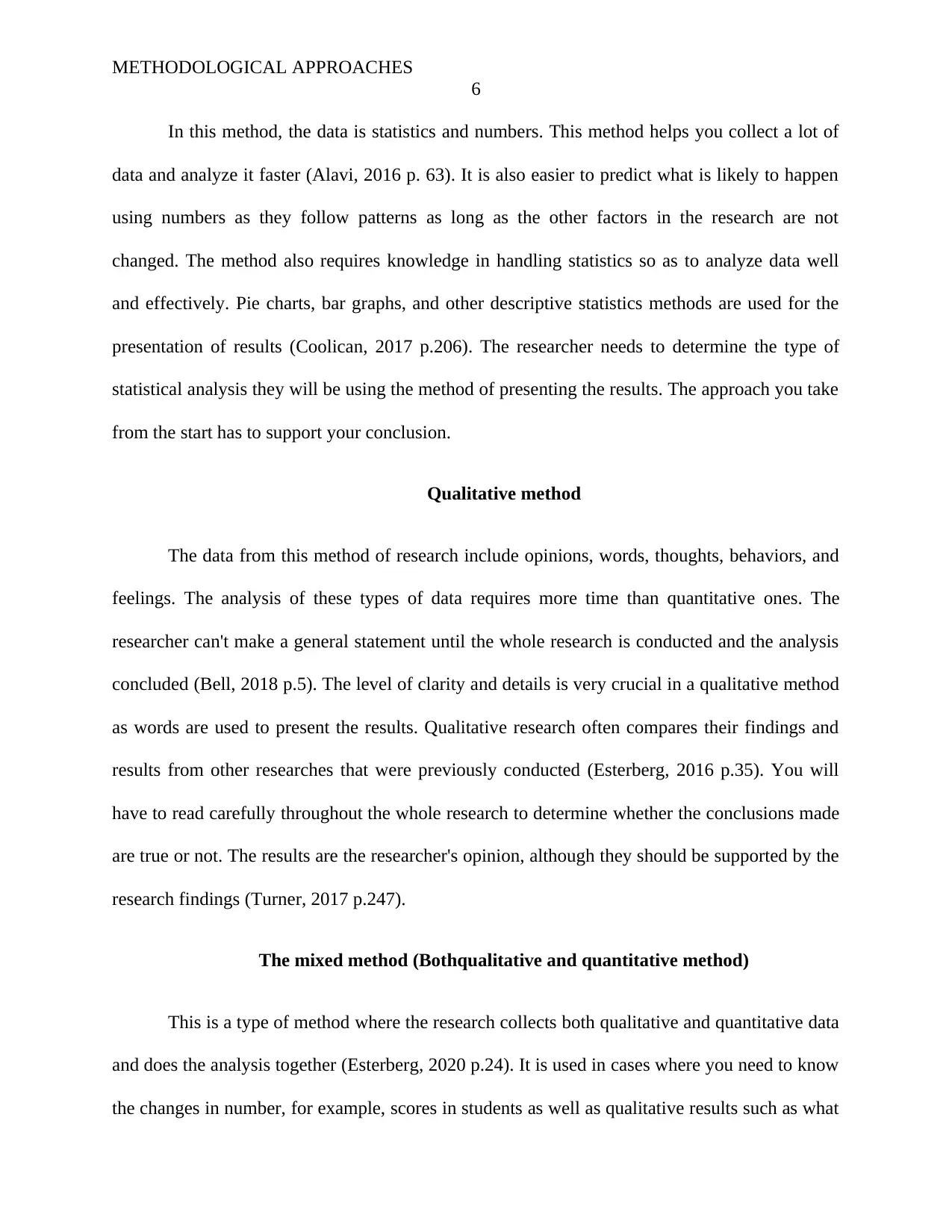
METHODOLOGICAL APPROACHES
6
In this method, the data is statistics and numbers. This method helps you collect a lot of
data and analyze it faster (Alavi, 2016 p. 63). It is also easier to predict what is likely to happen
using numbers as they follow patterns as long as the other factors in the research are not
changed. The method also requires knowledge in handling statistics so as to analyze data well
and effectively. Pie charts, bar graphs, and other descriptive statistics methods are used for the
presentation of results (Coolican, 2017 p.206). The researcher needs to determine the type of
statistical analysis they will be using the method of presenting the results. The approach you take
from the start has to support your conclusion.
Qualitative method
The data from this method of research include opinions, words, thoughts, behaviors, and
feelings. The analysis of these types of data requires more time than quantitative ones. The
researcher can't make a general statement until the whole research is conducted and the analysis
concluded (Bell, 2018 p.5). The level of clarity and details is very crucial in a qualitative method
as words are used to present the results. Qualitative research often compares their findings and
results from other researches that were previously conducted (Esterberg, 2016 p.35). You will
have to read carefully throughout the whole research to determine whether the conclusions made
are true or not. The results are the researcher's opinion, although they should be supported by the
research findings (Turner, 2017 p.247).
The mixed method (Bothqualitative and quantitative method)
This is a type of method where the research collects both qualitative and quantitative data
and does the analysis together (Esterberg, 2020 p.24). It is used in cases where you need to know
the changes in number, for example, scores in students as well as qualitative results such as what
6
In this method, the data is statistics and numbers. This method helps you collect a lot of
data and analyze it faster (Alavi, 2016 p. 63). It is also easier to predict what is likely to happen
using numbers as they follow patterns as long as the other factors in the research are not
changed. The method also requires knowledge in handling statistics so as to analyze data well
and effectively. Pie charts, bar graphs, and other descriptive statistics methods are used for the
presentation of results (Coolican, 2017 p.206). The researcher needs to determine the type of
statistical analysis they will be using the method of presenting the results. The approach you take
from the start has to support your conclusion.
Qualitative method
The data from this method of research include opinions, words, thoughts, behaviors, and
feelings. The analysis of these types of data requires more time than quantitative ones. The
researcher can't make a general statement until the whole research is conducted and the analysis
concluded (Bell, 2018 p.5). The level of clarity and details is very crucial in a qualitative method
as words are used to present the results. Qualitative research often compares their findings and
results from other researches that were previously conducted (Esterberg, 2016 p.35). You will
have to read carefully throughout the whole research to determine whether the conclusions made
are true or not. The results are the researcher's opinion, although they should be supported by the
research findings (Turner, 2017 p.247).
The mixed method (Bothqualitative and quantitative method)
This is a type of method where the research collects both qualitative and quantitative data
and does the analysis together (Esterberg, 2020 p.24). It is used in cases where you need to know
the changes in number, for example, scores in students as well as qualitative results such as what
⊘ This is a preview!⊘
Do you want full access?
Subscribe today to unlock all pages.

Trusted by 1+ million students worldwide
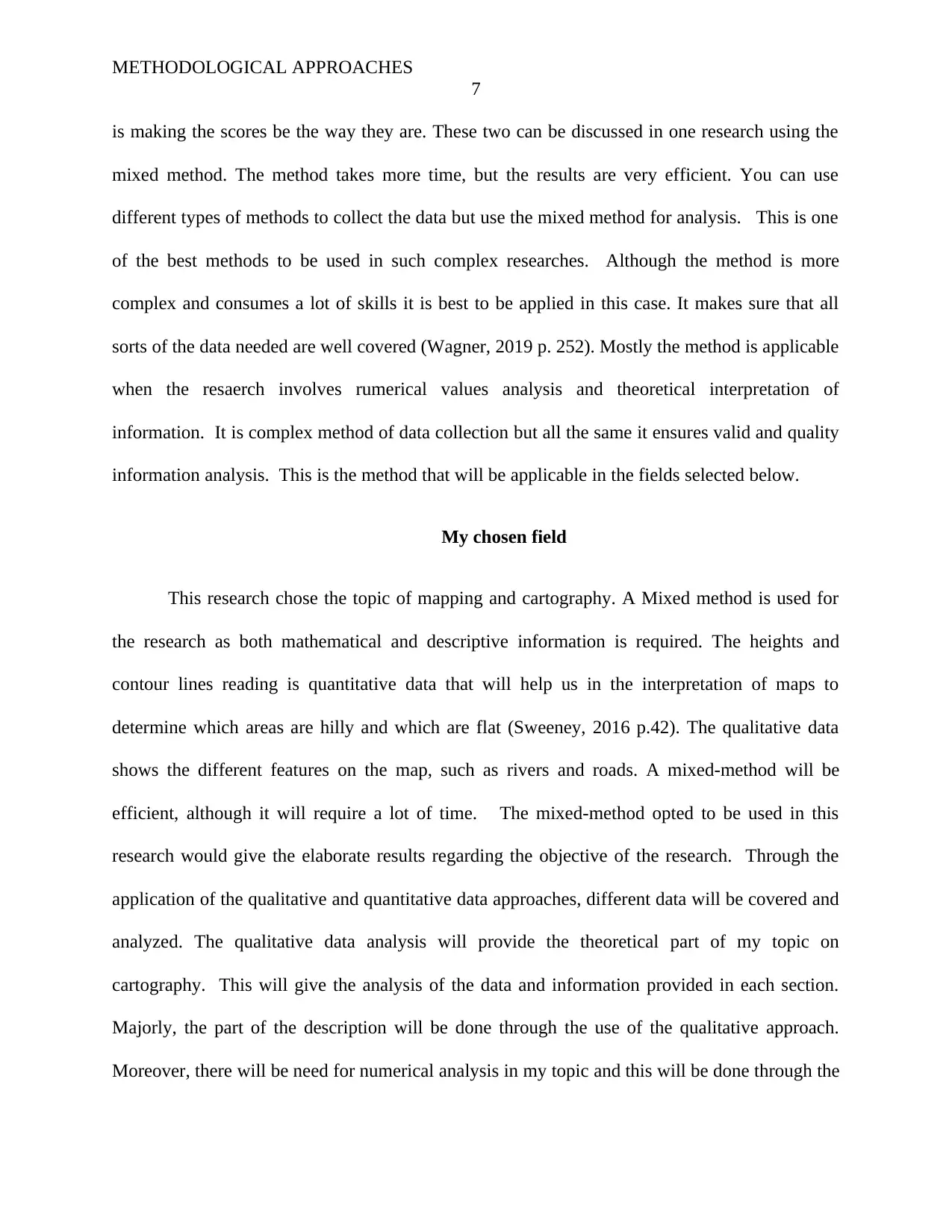
METHODOLOGICAL APPROACHES
7
is making the scores be the way they are. These two can be discussed in one research using the
mixed method. The method takes more time, but the results are very efficient. You can use
different types of methods to collect the data but use the mixed method for analysis. This is one
of the best methods to be used in such complex researches. Although the method is more
complex and consumes a lot of skills it is best to be applied in this case. It makes sure that all
sorts of the data needed are well covered (Wagner, 2019 p. 252). Mostly the method is applicable
when the resaerch involves rumerical values analysis and theoretical interpretation of
information. It is complex method of data collection but all the same it ensures valid and quality
information analysis. This is the method that will be applicable in the fields selected below.
My chosen field
This research chose the topic of mapping and cartography. A Mixed method is used for
the research as both mathematical and descriptive information is required. The heights and
contour lines reading is quantitative data that will help us in the interpretation of maps to
determine which areas are hilly and which are flat (Sweeney, 2016 p.42). The qualitative data
shows the different features on the map, such as rivers and roads. A mixed-method will be
efficient, although it will require a lot of time. The mixed-method opted to be used in this
research would give the elaborate results regarding the objective of the research. Through the
application of the qualitative and quantitative data approaches, different data will be covered and
analyzed. The qualitative data analysis will provide the theoretical part of my topic on
cartography. This will give the analysis of the data and information provided in each section.
Majorly, the part of the description will be done through the use of the qualitative approach.
Moreover, there will be need for numerical analysis in my topic and this will be done through the
7
is making the scores be the way they are. These two can be discussed in one research using the
mixed method. The method takes more time, but the results are very efficient. You can use
different types of methods to collect the data but use the mixed method for analysis. This is one
of the best methods to be used in such complex researches. Although the method is more
complex and consumes a lot of skills it is best to be applied in this case. It makes sure that all
sorts of the data needed are well covered (Wagner, 2019 p. 252). Mostly the method is applicable
when the resaerch involves rumerical values analysis and theoretical interpretation of
information. It is complex method of data collection but all the same it ensures valid and quality
information analysis. This is the method that will be applicable in the fields selected below.
My chosen field
This research chose the topic of mapping and cartography. A Mixed method is used for
the research as both mathematical and descriptive information is required. The heights and
contour lines reading is quantitative data that will help us in the interpretation of maps to
determine which areas are hilly and which are flat (Sweeney, 2016 p.42). The qualitative data
shows the different features on the map, such as rivers and roads. A mixed-method will be
efficient, although it will require a lot of time. The mixed-method opted to be used in this
research would give the elaborate results regarding the objective of the research. Through the
application of the qualitative and quantitative data approaches, different data will be covered and
analyzed. The qualitative data analysis will provide the theoretical part of my topic on
cartography. This will give the analysis of the data and information provided in each section.
Majorly, the part of the description will be done through the use of the qualitative approach.
Moreover, there will be need for numerical analysis in my topic and this will be done through the
Paraphrase This Document
Need a fresh take? Get an instant paraphrase of this document with our AI Paraphraser
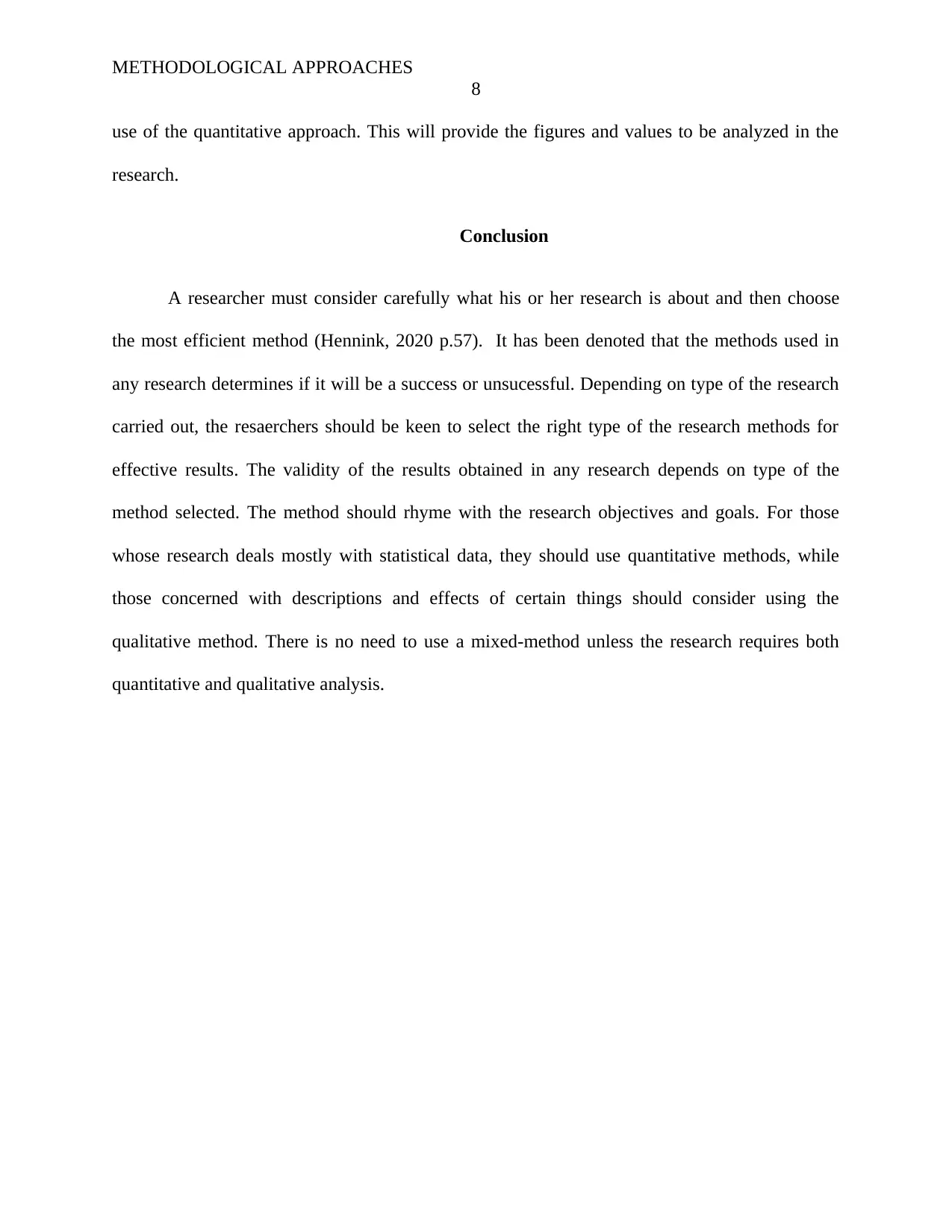
METHODOLOGICAL APPROACHES
8
use of the quantitative approach. This will provide the figures and values to be analyzed in the
research.
Conclusion
A researcher must consider carefully what his or her research is about and then choose
the most efficient method (Hennink, 2020 p.57). It has been denoted that the methods used in
any research determines if it will be a success or unsucessful. Depending on type of the research
carried out, the resaerchers should be keen to select the right type of the research methods for
effective results. The validity of the results obtained in any research depends on type of the
method selected. The method should rhyme with the research objectives and goals. For those
whose research deals mostly with statistical data, they should use quantitative methods, while
those concerned with descriptions and effects of certain things should consider using the
qualitative method. There is no need to use a mixed-method unless the research requires both
quantitative and qualitative analysis.
8
use of the quantitative approach. This will provide the figures and values to be analyzed in the
research.
Conclusion
A researcher must consider carefully what his or her research is about and then choose
the most efficient method (Hennink, 2020 p.57). It has been denoted that the methods used in
any research determines if it will be a success or unsucessful. Depending on type of the research
carried out, the resaerchers should be keen to select the right type of the research methods for
effective results. The validity of the results obtained in any research depends on type of the
method selected. The method should rhyme with the research objectives and goals. For those
whose research deals mostly with statistical data, they should use quantitative methods, while
those concerned with descriptions and effects of certain things should consider using the
qualitative method. There is no need to use a mixed-method unless the research requires both
quantitative and qualitative analysis.

METHODOLOGICAL APPROACHES
9
References
Alavi, H. and Hąbek, P., 2016. Addressing research design problem in mixed methods research.
Management Systems in Production Engineering, 21(1), pp.62-66.
Bell, E. 2018. Business research methods. Oxford university press. pp. 2-15.
Bryman, A., 2016. Social research methods.Oxford university press. pp. 112-120.
Coolican, H., 2017. Research methods and statistics in psychology.Psychology Press. pp 203-
222.
Esterberg, K.G., 2016. Qualitative methods in social research. pp. 34-38
Ghauri, P. 2020. Research methods in business studies. Cambridge University Press. pp. 120-
133.
Hennink, M., 2020.Qualitative research methods. SAGE Publications Limited. pp. 56-77.
Patton, M.Q., 2017. Qualitative evaluation and research methods. SAGE Publications, inc. pp
330-360.
Sweeney, M., 2016, January. An exploration of mixed research methods in planned event
studies. In Journal of Convention & Event Tourism (Vol. 17, No. 1, pp.41-54).
Routledge.
Turner, S.F., 2017. Research design for mixed methods: A triangulation-based framework and
roadmap. Organizational Research Methods, 20(2), pp.243-267.
Veal, A.J., 2017.Research methods for leisure and tourism. Pearson UK. pp.14-23
9
References
Alavi, H. and Hąbek, P., 2016. Addressing research design problem in mixed methods research.
Management Systems in Production Engineering, 21(1), pp.62-66.
Bell, E. 2018. Business research methods. Oxford university press. pp. 2-15.
Bryman, A., 2016. Social research methods.Oxford university press. pp. 112-120.
Coolican, H., 2017. Research methods and statistics in psychology.Psychology Press. pp 203-
222.
Esterberg, K.G., 2016. Qualitative methods in social research. pp. 34-38
Ghauri, P. 2020. Research methods in business studies. Cambridge University Press. pp. 120-
133.
Hennink, M., 2020.Qualitative research methods. SAGE Publications Limited. pp. 56-77.
Patton, M.Q., 2017. Qualitative evaluation and research methods. SAGE Publications, inc. pp
330-360.
Sweeney, M., 2016, January. An exploration of mixed research methods in planned event
studies. In Journal of Convention & Event Tourism (Vol. 17, No. 1, pp.41-54).
Routledge.
Turner, S.F., 2017. Research design for mixed methods: A triangulation-based framework and
roadmap. Organizational Research Methods, 20(2), pp.243-267.
Veal, A.J., 2017.Research methods for leisure and tourism. Pearson UK. pp.14-23
⊘ This is a preview!⊘
Do you want full access?
Subscribe today to unlock all pages.

Trusted by 1+ million students worldwide
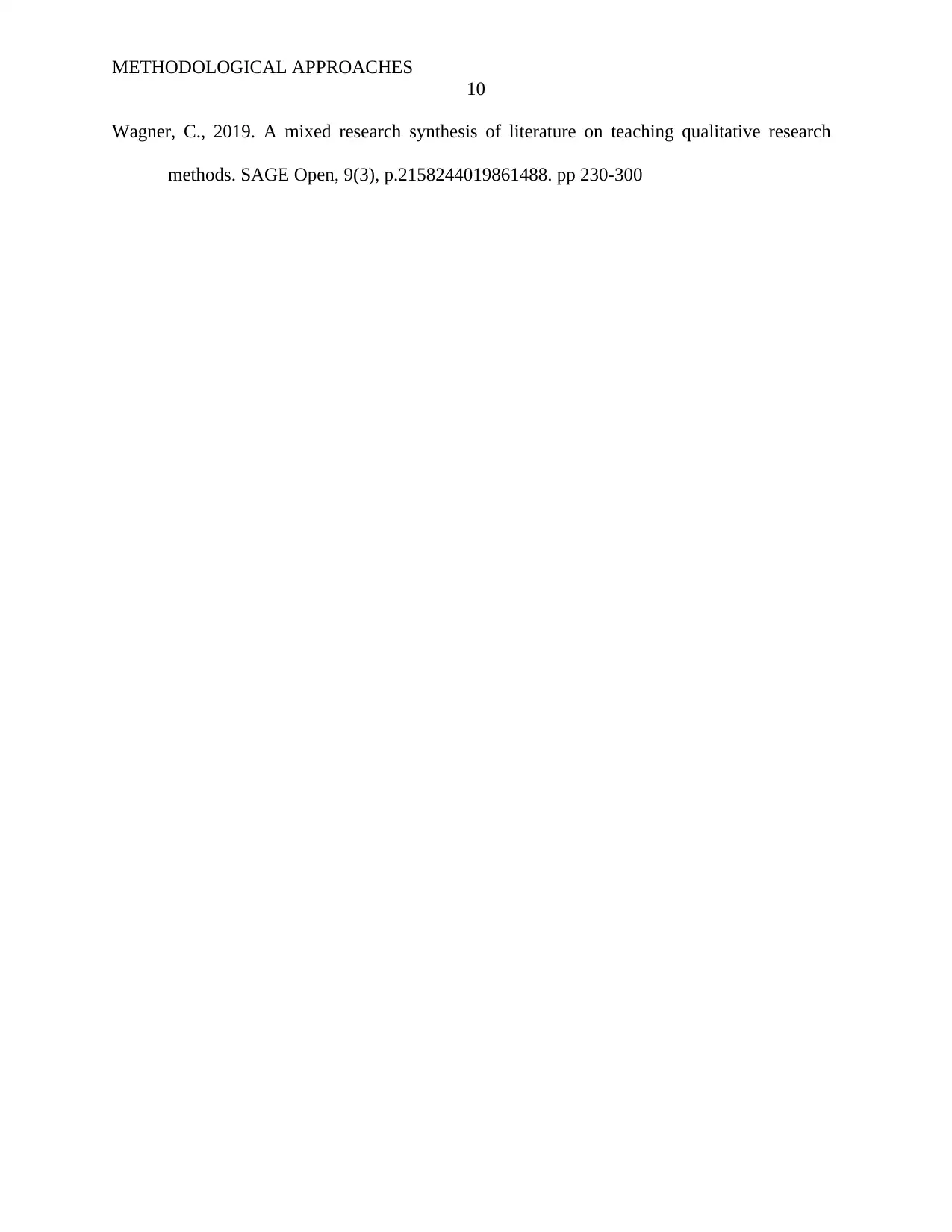
METHODOLOGICAL APPROACHES
10
Wagner, C., 2019. A mixed research synthesis of literature on teaching qualitative research
methods. SAGE Open, 9(3), p.2158244019861488. pp 230-300
10
Wagner, C., 2019. A mixed research synthesis of literature on teaching qualitative research
methods. SAGE Open, 9(3), p.2158244019861488. pp 230-300
1 out of 10
Related Documents
Your All-in-One AI-Powered Toolkit for Academic Success.
+13062052269
info@desklib.com
Available 24*7 on WhatsApp / Email
![[object Object]](/_next/static/media/star-bottom.7253800d.svg)
Unlock your academic potential
Copyright © 2020–2025 A2Z Services. All Rights Reserved. Developed and managed by ZUCOL.





